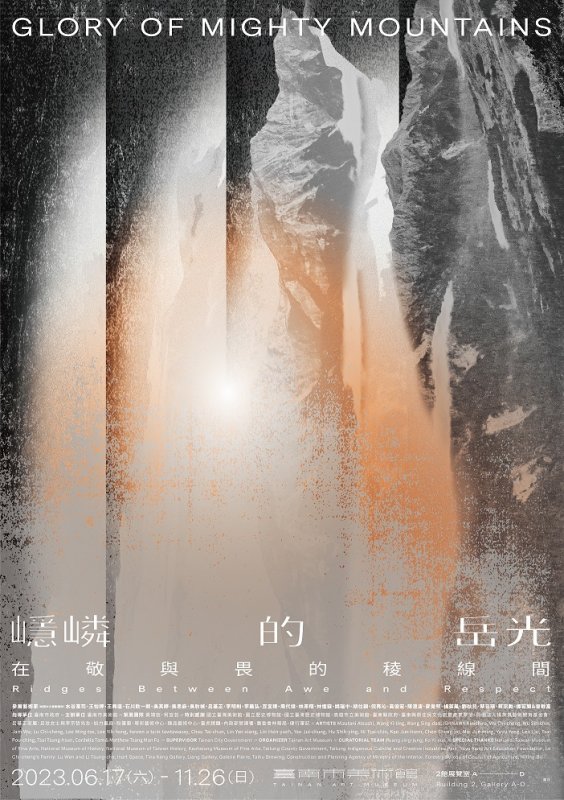嶾嶙的岳光:在敬與畏的稜線間
Glory of Mighty Mountains: Ridges between Awe and RespectRidges between Awe and Respect

展覽時間:2023.06.17~2023.11.26
展覽地點:臺南市美術館2館 展覽室A-D
Tainan Art Museum Building 2, Gallery A-D
展覽論述 Curatorial Concept
「山」是經由板塊運動所形成的高聳自然,是臺灣島嶼上面積最大、最鮮明的帶狀。山的矗立猶如天上一道光,既神聖溫暖,又高深莫測,使人對其崇敬及畏懼。隨著時空的流轉,在這樣的敬畏之間,「人」之於「山」的態度與觸及發展出多樣關係,而我們也在未知裡逐漸把握已知,甚至探索已知外更多的未知。山與人的情感是有機的連動,不斷更新的篇章。
「人」對於「山」的敬畏兼具感性與理性,在物理世界及精神世界來回脈動。對於高山上的自然景象,人時常延伸想像,加入信仰及神鬼等的成分,並與山林活動的植物、動物、人等萬物之靈,創造了各種使人有所意會及言傳的故事。縱然山是如此莫測,然而彷彿在自然崇高之光的召喚下,人仍然具有挑戰未知事物的勇氣,帶著探索的實驗精神趨向山林。「山」之於「人」的距離,也在臺灣歷史、地理的脈動、視角與態度轉化下構築出多重樣態。
「嶾嶙」形容山的崇高,「岳光」表示山岳的光芒,就像人們看見「觀音圈」(Glory/ Brockengespenst)而生的敬畏,是虛幻也是真實,是心理感召亦是物理世界流轉的痕跡;而「岳光」也宛如與我們同在的山林光景,如此貼近。「稜線」代表物體兩面相交所形成的線,山與山的交疊、人與山的交疊都成為「稜線」;除了身體性,在雲霧之間,「稜線」每每因光線角度的反射,形成豐富的樣貌及綿延不止的景觀,猶如人對於山的認知和想像永不間斷、變化多端,遙遠卻也親近。展覽副標「在敬與畏的稜線間」更將主詞與動詞省略,保留空間給與山接觸的人事物,以及他們與山發生關聯的不同能動性。
臺南市美術館「嶾嶙的岳光:在敬與畏的稜線間」以「幽明的靈動之域」、「循著明晰的光」、「與山林共譜」三個子題,述說山的崇高到親近、神秘到熟悉,以及山林之光映照下,人心理及身體的敬畏經驗所構成的「山」的感知連結,試圖探討臺灣這片土地上,山與人的多元共存模式,以及人記錄和經驗山的方式。
As an elevated portion on Earth formed through plate motions, mountains are the largest, most noticeable natural terrain in Taiwan. These mighty peaks are like a beam of light in the sky, seeming so sacred and warm but also mysterious at the same time, inspiring awe and respect among people. As such, human–mountain attitudes and interactions have diversified, while humans smartly utilize the knowns and proceed to explore the unknowns. The dynamic human–mountain relationship has been continually changing without stop.
People’s awe and respect of mountains comes with sense and sensibility, shuffling back and forth between the physical world and the spiritual one. Humans often expand their imagination about natural scenes high up in the mountains by adding belief-related and supernatural elements, and create various stories about all the living things—including plants, animals, and humans—interacting with mountains and forests that have been told throughout the history. Facing enigmatic mountains, human beings are courageous enough to challenge the unknowns and explore mountains with experimental spirits, as if they have been summoned by the sublime light of nature. The distance between humans and mountains have also established a wide range of patterns among the historical and geological shifts in Taiwan as well as changes in different perspectives and attitudes.
The “Glory” represents mountain light, while “Sublime” describes the mightiness of mountains. Like the mixed feeling of awe and respect triggered by Glory/Brockengespenst, the Glory of Sublime Mountains is both imaginary and real and signifies mental calling and changes in the physical world, with the glory per se being part of mountain scenery that is so close to us. As lines between two planes of an object, the “Ridges” exemplify intersections between mountains and those between humans and mountains. Thanks to light coming in different angles amidst the clouds and mist, these ridges, in addition to corporeality, form abundant and endless landscapes, implying human’s ever-changing understanding of and imaginations about mountains that seem distant and close at the same time. The subtitle “Ridges between Awe and Respect” omits the subject and verb, leaving some room for people, incidents, and objects in contact with mountains as well as their different agency in relation to mountains.
The exhibition “Glory of Sublime Mountains: Ridges between Awe and Respect” held in the Tainan Art Museum comprises three subthemes, namely “The Realm of Spiritual Motions between Brightness and Darkness”, “Following the Clear and Bright Light”, and “Co-creation with Mountains”, each describing various aspects of mountains from their mightiness to closeness and mystery to familiarity, and that how humans physically and mentally perceive and relate themselves with mountains using experience gained through awe and respect. The exhibition attempts to explore the various patterns of human–mountain coexistence in Taiwan as well as how human beings record and experience such natural terrain on the island.
指導單位:臺南市政府
Supervisor: Tainan City Government
主辦單位:臺南市美術館
Organizer: Tainan Art Museum
策展團隊:黃靖容、柯宜芸
Curatorial Team: Huang Jing-jung, Ko Yi-yun
參展藝術家(依照中文筆劃順序):水谷篤司、王怡婷、王興道、石川欽一郎、吳其錚、吳思嶔、吳耿禎、呂基正、李明則、李義弘、豆宜臻、周代焌、林彥翔、林惺嶽、姚瑞中、胡仕穎、倪再沁、高俊宏、陳澄波、麥覺明、楊英風、劉秋兒、蔡咅璟、蔡宗勳、譚若蘭&曾敏富
Artists: Mizutani Atsushi, Wang Yi-ting, Wang Sing-dao, ISHIKAWA Kinichiro, Wu Chi-cheng, Wu Sih-chin, Jam Wu, Lu Chi-cheng, Lee Ming-tse, Lee Yih-hong, hewen a ta:in tawtawazay, Chou Tai-chun, Lin Yan-xiang, Lin Hsin-yueh, Yao Jui-chung, Hu Shih-ying, Ni Tsai-chin, Kao Jun-honn, Chen Cheng-po, Mai Jue-ming , Yuyu Yang, Leo Liu, Tsai Pou-ching, Tsai Tsung-hsun, Cordelia Tam & Matthew Tsang Man Fu
特別感謝:國立臺灣美術館、國立歷史博物館、國立臺灣歷史博物館、高雄市立美術館、臺東縣政府、臺東縣原住民文化創意產業聚落、財團法人楊英風藝術教育基金會、呂基正家屬:呂玟女士與李宗哲先生、加力畫廊、耿畫廊、尊彩藝術中心、臻品藝術中心、臺虎精釀、內政部營建署、農委會林務局、健行筆記
Special Thanks: National Taiwan Museum of Fine Arts, National Museum of History, National Museum of Taiwan History, Kaohsiung Museum of Fine Arts, Taitung County Government, Taitung Indigenous Cultural and Creative Industries Park, Yuyu Yang Art Education Foundation, Lu Chi-cheng’s Family: Lu Wen and Li Tsung-che, Inart Space, Tina Keng Gallery, Liang Gallery, Galerie Pierre, Taihu Brewing, Construction and Planning Agency of Ministry of the Interior, Forestry Bureau of Council of Agriculture, Hiking Biji
|展覽官網|https://www.tnam.museum/exhibition/detail/417